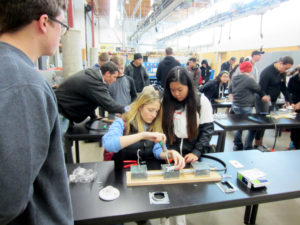Oregon’s third-worst-in-the-nation graduation rate is nothing to be proud of. But with Oregon taxpayers and legislators directing more money to Career Technical Education courses, there’s reason to believe the investments could keep more teens on track and set them up for success after graduation.
A recent news story out of the Eugene-Springfield area pointed to the role of CTE programs in boosting graduation rates in Lane County and across the state while also helping students jump start a career.
The Associated Press reports that in Oregon, students enrolled in CTE programs are 15.5 percentage points more likely to graduate from high school in four years than students who do not take the courses, according to data from the Oregon Department of Education.
Additionally, the AP said, students of all races and ethnicities who are enrolled in such classes graduate at higher levels than the statewide average of 74 percent, state data show.
In Portland Public Schools, the overall graduation rate during the 2013-14 school year was 72 percent; among students who completed at least two CTE classes, it was 91 percent, the AP said.
 What were once known as vocational courses have evolved beyond home economics and woodworking to include business management, construction technology, digital media and graphic design, engineering, culinary arts and more.
What were once known as vocational courses have evolved beyond home economics and woodworking to include business management, construction technology, digital media and graphic design, engineering, culinary arts and more.
To encourage the growth of CTE programs, the Oregon Legislature appropriated just under $9 million during the 2015-17 biennium to motivate districts across the state “to provide high-quality CTE programs to qualify students for living-wage, in-demand occupations,” the AP reported.
The funding is based on the number of students who enrolled in such programs the previous school year and earned credits in an approved CTE program.
In November, taxpayers significantly raised the stakes by passing Measure 98, a proposal to pump $150 million a year, roughly $800 per student, into a fund to help high schools drive graduation rates higher, according to The Oregonian/OregonLive. That’s on top of the approximately $11,000 per student per year that Oregon currently commits to K-12.
Schools would get the extra money by adding career-technical courses, providing more college credit classes, and doing more with dropout intervention programs – all three of which have been shown to make a difference, The Oregonian/OregonLive noted.
Leyah Krimbow, a freshman at Springfield High School, told The Register-Guard in Eugene that since enrolling in an introductory automotive class, her grades and attitude toward school have improved and she now wants to an aeronautical engineer.
“Auto (class) has helped with everything, absolutely everything. It’s a big motivator. It gets me to come to school in the morning because it’s my first class,” Krimbow said. “It holds me accountable to get good grades in my other classes, and it’s given me so many college credits. These classes have changed my life completely.”
Read more about the difference CTE classes are making in Lane County schools.



